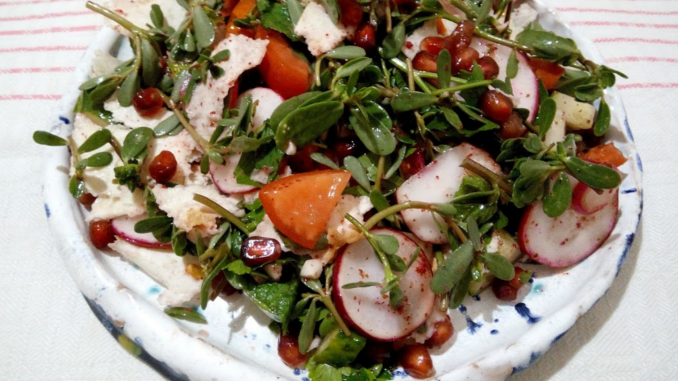
Many of America’s health problems could be prevented if people chose to eat healthy and nutritious foods instead of processed foods. While processed foods are convenient, they’ve had the majority of the nutrients, vitamins, and minerals removed, along with the associated health benefits.
A prime example of a natural and nutrient-rich food is Portulaca, a genus of succulent plant with over forty species. At least one of these species, Portulaca oleracea, commonly called purslane (also pursley, red root, or verdolaga), is edible and extremely nutritious. Broadly used in Eastern Mediterranean cooking, it is also consumed in the Middle East, Asia, Europe, and many countries in other regions around the world. Purslane is grown all around the globe, including the United States, but is virtually unknown to most Americans.
Among the possibilities, you can have it raw on salads, in a stir-fry, in soups, stews, and other cooked foods to add a crunchy texture, or blend it into smoothies. The taste of purslane is said to be slightly sour and salty (perhaps something like capers?) and has been compared to both spinach and watercress.
The herb, long used in traditional medicines, is beneficial to the cardiovascular system, digestive system, immune system, skin, and bones. It has been reputed since ancient times to make a good skin lotion to treat irritation and speed healing. Pliny the Elder wrote of its power in Natural History. Today, purslane is known to have antimicrobial, antidiabetic, and anti-inflammatory properties. It’s also a cure for scurvy, can reduce a fever, and is used to detoxify.
Purslane contains loads of goodies your body needs, starting with calcium, iron, magnesium, phosphorus, potassium, zinc, copper, manganese, and selenium. It’s high in vitamin C, contains significant amounts of vitamin A, and many vitamins from the vitamin B-group including Thiamin (B1), Riboflavin (B2), Niacin (B3), Pantothenic acid (B5), Vitamin B6, Folate (B9), and Folic acid (B9). Also, it’s low in carbs and calories, and has zero fatty acids and zero cholesterol.
Another nutritional necessity purslane contains is plant-based (ALA, alpha-linolenic acid) omega-3, which is good for the immune system and can help reduce your risk of coronary heart disease.
Last but not least, purslane contains the antioxidants alpha-Tocopherol (vitamin E), ascorbic acid (vitamin C – good for the heart), beta-carotene, and glutathione.
Warnings and Caveats
Purslanes self-propogates freely and easily. It is considered invasive and will spread beyond wherever it is planted. To prevent this, cut off the flowering buds before they become seed pods and disperse the tiny black seeds.
Purslane contains high levels of oxalate, so people who have kidney stones or are at risk should take care not to eat purslane raw. High levels of oxalates can also adversely affect mineral absorption. However, boiling purslane reduces oxalate levels.
If you are intrepid enough to forage for wild edible plants, beware of the
Hairy-Stemmed Spurge, a poisonous plant that can be mistaken for purslane.
Conclusion
Purslane will grow almost anywhere. It likes warm climates, dry conditions, and thrives even in poor soil. Purslane is often available at nurseries in a pot and sold as an ornamental annual. An extremely versatile plant, it also makes an attractive groundcover.
An extensive article on purslane with many links to research papers and government health-related websites may be found at:
www.healthyandnaturalworld.com/purslane/
Learn to avoid quick, convenient, processed foods which have essentially had all the nutrients, vitamins, and minerals removed.
Question of the night: What’s the best salad? And what do you like on it?
